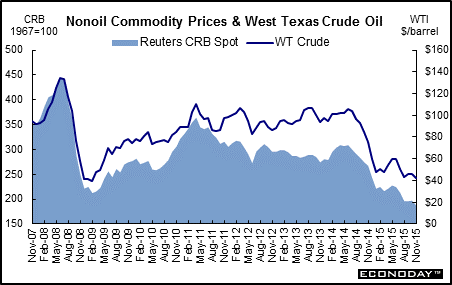
|
Long Term Perspective Since the Fed is so keen on keeping inflation low, the Fed cannot simply wait until monthly data on the consumer price index or the PCE price index are showing a boost in inflation. Consequently, Fed officials closely monitor commodity prices of all stripes. In addition to giving clues on inflation trends, changes in commodity prices reveal strength or weakness in economic activity as well. When commodity prices are rising rapidly, this often suggests that industrial activity is picking up steam. Conversely, when commodity prices are falling, industrial activity might be waning. The chart below depicts a spot commodity index that does not include any energy prices.
Oil is important to all facets of our life and thus oil prices are a key indicator that could signal potential inflationary pressures or changes in economic growth. The economy often moderates in response to rapidly rising oil prices – and each of the recessions since 1971 have been preceded by an oil price shock. The 1970s Fed was blamed for exacerbating the inflation spiral by pursuing overly accommodative policy during the oil embargo. Since then, the Fed has operated more carefully when sharp oil price changes have jolted the U.S. economy.
Crude oil prices rose sharply during the first half of 2008 into early July of that year. Record highs were set during this period due to strong worldwide demand, a drop in the dollar, heavy speculation, and political instability in some oil-producing regions as well as tensions between the U.S. and Iran. In July 2008, the spot price for West Texas Intermediate (WTI) reached a then record high $145.29 per barrel. Recession worries pushed prices down during latter 2008 and early 2009. But recovery in the U.S. and Europe and strong demand from Asia pushed oil prices back up in 2010 and into early 2011. Demand for commodities strengthened notably over that period. Oil also was boosted by supply concerns from civil war in Libya and other civil unrest in North Africa and the Middle East. WTI held in a narrow range roughly between $100 and $90 until October 2014 when prices began to buckle, pulling WTI below $50 in early in 2015 and then below $40 in late 2015. Slowing global demand was one factor pulling prices down as was increased oil production by the United States and especially Saudi Arabia, the latter raising output to lower the value of oil and push out high-cost alternative energy plays in the United States.
Short Term Perspective The futures commodity price index depicted below includes unleaded gasoline which, however, is the only energy component among industrials, grains, livestock & meat and precious metal prices. Though this index does not always move in sync with crude oil prices, it is not unusual to see many types of commodity prices move in tandem since the same economic factors often affects them all. As of December 2015, WTI was very volatile, at about $35 per barrel and down by nearly 2/3 from $100 in mid-2014 for the lowest price in more than 10 years. The RJ/CRB commodity futures index for the same period was down more than 30 percent on a year-ago basis.
|
|||||||
| Legal Notices | ©Copyright 1998-2024 Econoday, Inc. |
powered by
![[Econoday]](images/logo.gif)
![[Apple App Store]](/images/AppleAppStore.png) ![[Econoday on Kindle]](/images/kindle.jpg) 
|
||||||

